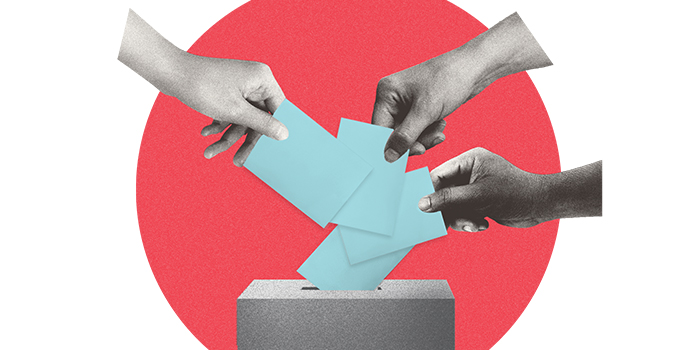The Voting Rights Act
The ภฯฐฤรลฟชฝฑฝแน๛ works in courts, legislatures, and communities to defend and preserve the individual rights and liberties that the Constitution and the laws of the United States guarantee everyone in this country.

The Latest
Explore More
What's at Stake
Since 1965, the Voting Rights Act (VRA) has protected voters of color from practices that make it harder for them to vote and those that unfairly diminish their voter power. The ภฯฐฤรลฟชฝฑฝแน๛ has been at the forefront of efforts to protect and strengthen the VRA both in the Court and in Congress. In recent years, however, the VRA has faced major challenges in both areas.
Despite a strong bipartisan reauthorization of the VRA in 2006, the U.S. Supreme Court struck a blow against one of the Actโs most significant provisions 2013 when it issued its decision in Shelby County v. Holder. Before this decision, states and localities with significant histories of voter discrimination were required to get federal approval before making changes to their voting laws or districts (โpreclearanceโ) to ensure that they did not worsen voting opportunities for voters of color. The Court ruled, however, that the manner of determining which jurisdictions needed preclearance (the โcoverage formulaโ) was unconstitutional, claiming it was out of date and unfairly punished the South.
While the Supreme Court ruling did not eliminate Section 5 itself, it meant states without long histories of discrimination no longer needed to preclear changes to their voting practices or districts unless and until Congress was able to develop a new coverage formula. This decision meant that states were able to swiftly implement new voting restrictions at levels unseen since Jim Crow.
As efforts to rely upon federal voting rights protections to attack discriminatory voting laws and districting continue, the VRA has faced further attacks. Although the ภฯฐฤรลฟชฝฑฝแน๛ and civil rights partners successfully defended the ability to challenge legislative districts that unfairly suppress the voting power of Black and Brown voters under Section 2 of the VRA in Allen v. Milligan in 2023, the Court weakened the ability to use Section 2 of the VRA to challenge laws that disproportionately burden voters of color equal access to voting in its decision in Brnovich v. DNC in 2022. The VRA has also faced efforts to unsettle foundational parts of the VRA that have long seemed settled such as the ability of private individuals, which includes impacted voters and organizations like the ภฯฐฤรลฟชฝฑฝแน๛, to challenge discriminatory voting laws under Section 2 of the VRA.
Given this onslaught of attacks, Congress must act now to protect chip away at whatโs left of the VRA and to restore it to its prior glory. The ภฯฐฤรลฟชฝฑฝแน๛ has been actively collaborating with partners to push Congress towards this goal. The keystone of these efforts is the John R. Lewis Voting Rights Advancement Act, which would restore and strengthen the VRA, including its preclearance provision.
Learn more about the ภฯฐฤรลฟชฝฑฝแน๛โs efforts to restore the VRA to its former glory and protect the right to vote for all.
Related Resources:
Report: The Imperative of Restoring and Strengthening the Voting Rights Act (Mar. 2024)
(Time stamp 1:07:20)
March 2024 Written Testimony before Senate Judiciary Committee
Report: The Case for Restoring and Updating the Voting Rights Act (Aug. 2021)
Report: The Case for Restoring and Updating the Voting Rights Act (Nov. 2019)
Timeline of the Voting Rights Act
Voter Suppression Laws: Whatโs New Since the 2012 Presidential Election [MAP]
Coalition Letter to Debate Hosts Urging Inclusion of Voting Rights
The Battle to Protect the Ballot: Voter Suppression Measures Passed Since 2013 [MAP]
Since 1965, the Voting Rights Act (VRA) has protected voters of color from practices that make it harder for them to vote and those that unfairly diminish their voter power. The ภฯฐฤรลฟชฝฑฝแน๛ has been at the forefront of efforts to protect and strengthen the VRA both in the Court and in Congress. In recent years, however, the VRA has faced major challenges in both areas.
Despite a strong bipartisan reauthorization of the VRA in 2006, the U.S. Supreme Court struck a blow against one of the Actโs most significant provisions 2013 when it issued its decision in Shelby County v. Holder. Before this decision, states and localities with significant histories of voter discrimination were required to get federal approval before making changes to their voting laws or districts (โpreclearanceโ) to ensure that they did not worsen voting opportunities for voters of color. The Court ruled, however, that the manner of determining which jurisdictions needed preclearance (the โcoverage formulaโ) was unconstitutional, claiming it was out of date and unfairly punished the South.
While the Supreme Court ruling did not eliminate Section 5 itself, it meant states without long histories of discrimination no longer needed to preclear changes to their voting practices or districts unless and until Congress was able to develop a new coverage formula. This decision meant that states were able to swiftly implement new voting restrictions at levels unseen since Jim Crow.
As efforts to rely upon federal voting rights protections to attack discriminatory voting laws and districting continue, the VRA has faced further attacks. Although the ภฯฐฤรลฟชฝฑฝแน๛ and civil rights partners successfully defended the ability to challenge legislative districts that unfairly suppress the voting power of Black and Brown voters under Section 2 of the VRA in Allen v. Milligan in 2023, the Court weakened the ability to use Section 2 of the VRA to challenge laws that disproportionately burden voters of color equal access to voting in its decision in Brnovich v. DNC in 2022. The VRA has also faced efforts to unsettle foundational parts of the VRA that have long seemed settled such as the ability of private individuals, which includes impacted voters and organizations like the ภฯฐฤรลฟชฝฑฝแน๛, to challenge discriminatory voting laws under Section 2 of the VRA.
Given this onslaught of attacks, Congress must act now to protect chip away at whatโs left of the VRA and to restore it to its prior glory. The ภฯฐฤรลฟชฝฑฝแน๛ has been actively collaborating with partners to push Congress towards this goal. The keystone of these efforts is the John R. Lewis Voting Rights Advancement Act, which would restore and strengthen the VRA, including its preclearance provision.
Learn more about the ภฯฐฤรลฟชฝฑฝแน๛โs efforts to restore the VRA to its former glory and protect the right to vote for all.
Related Resources:
Report: The Imperative of Restoring and Strengthening the Voting Rights Act (Mar. 2024)
(Time stamp 1:07:20)
March 2024 Written Testimony before Senate Judiciary Committee
Report: The Case for Restoring and Updating the Voting Rights Act (Aug. 2021)
Report: The Case for Restoring and Updating the Voting Rights Act (Nov. 2019)
Timeline of the Voting Rights Act
Voter Suppression Laws: Whatโs New Since the 2012 Presidential Election [MAP]
Coalition Letter to Debate Hosts Urging Inclusion of Voting Rights
The Battle to Protect the Ballot: Voter Suppression Measures Passed Since 2013 [MAP]



